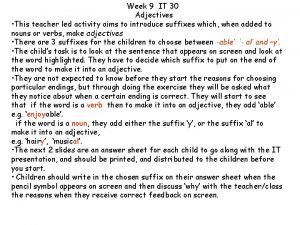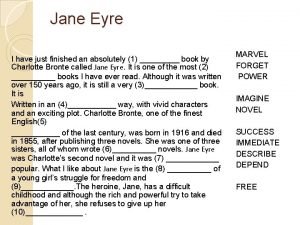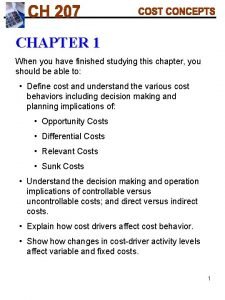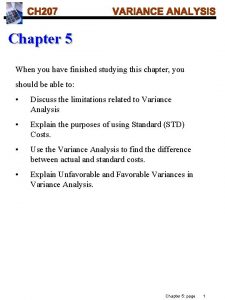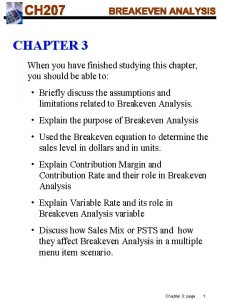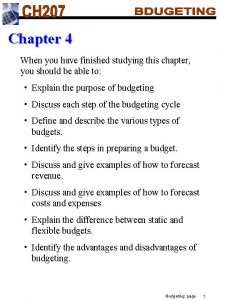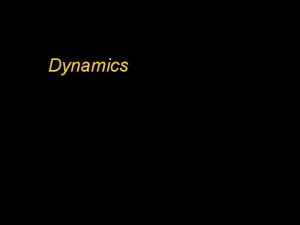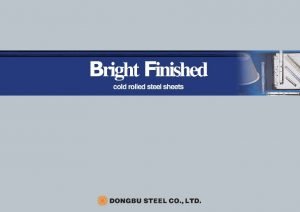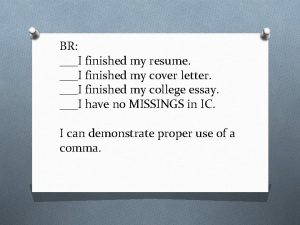Chapter 10 When you have finished studying this











- Slides: 11

Chapter 10 When you have finished studying this chapter, you should be able to: • Briefly discuss the purpose of menu engineering. • Explain the four classification of menu engineering • Stars • Plowhorses • Puzzles • Dogs • Use the menu engineering worksheet for menu analysis. • Calculate the Profitability and Popularity Factors in menu engineering. • Use information from menu engineering worksheet to prepare a menu engineering graph. • Discuss the limitations of menu engineering. Chapter 10: page 1

MENU ENGINEERING: • This method was developed by Smith and Kasavana. It provides the manager with information about a menu item’s profitability and popularity. • This method rates the menu by measuring each entrée as to its profitability (gross profit) and its sales. It then combines these measurements and places each menu item into one of four classifications: • • STAR PLOWHORSE PUZZLE DOG Chapter 10: page 2

MENU ENGINEERING: • Menu engineering addresses the concept of profitability by emphasizing the gross profit or contribution margin (CM) which is: Food Sales – Food Costs • CM for each menu item can be calculated by using the Selling Price for each menu item and subtracting it from its individual Food Costs. • Individual Food Costs for each menu item should be the total costs, including garnish, accompaniments served with entrée such as salad, potatoes, rolls, butter etc. . Chapter 10: page 3

CONTRIBUTION MARGIN: • Data in Columns A, B and C are given • Food Cost % = Cost / Selling Price or C / B • Contribution Margin = Selling Price – Cost or B - C Chapter 10: page 4

CONTRIBUTION MARGIN AND MENU MIX: • Data in Columns A, B, C, and F are given • Menu Mix in column G is calculated using the Number Sold (column F) for each menu item and dividing it by the Total of Number Sold (Column K). • Menu Sales (column H) and Menu Costs (column I) are calculated by multiplying Selling Price (column B) and Cost (column C) with Number Sold (column F) respectively. Chapter 10: page 5

MENU ITEMS POPULARITY AND AVERAGE CM: • Average CM (Col. Q) is calculated by dividing Total Menu CM (Col O) by Total Number Sold (Col K). Chapter 10: page 6

POPULARITY AND PROFITABILITY FACTORS: • The Popularity factor (Col. P) is calculated by dividing 100% by the number of menu items and multiply it by 70%. In this case, (100% / 5) = 0. 20 * 0. 70 = 0. 14. • Menu engineering considers an item popular if it represents 70% of its share of expected sales. • The Profitability factor, the Average CM (Col. Q), is calculated by dividing Total Menu CM (Col O) by Total Number Sold (Col K). In this case, $5485. 48 / 1295 = $4. 24 • The Popularity factor of 0. 14 now becomes the Desired Popularity and will be compared with each menu item’s sales mix. • The Profitability factor of $4. 24 now becomes the Desired CM and will be compared with each menu item’s CM. Chapter 10: page 7

MENU MIX (MM) AND CONTRIBUTION MARGIN (CM) COMPARISONS: • Menu Mix (Col. G) for each menu item are compare with Desired Popularity (Col. S) to determine the Menu Mix category (Col. T). If Col. G is higher than Col. S, it will be classified as High (H). If Col. G is lower than Col. S, it will be classified as Low (L). • Contribution Margin (Col. E) for each menu item are compare with Desired CM (Col. R) to determine the Contribution Margin category (Col. U). If Col. E is higher than Col. R, it will be classified as High (H). If Col. E is lower than Col. R, it will be classified as Low (L). Chapter 10: page 8

MENU ENGINEERING CLASSIFICATION: • Each menu item now are have both MM Category (Col. T) and CM Category (Col. U). • Menu Engineering classified menu items based on both MM and CM categories as follows: • • MM = High MM = Low CM = High CM = Low : : STAR PLOWHORSE PUZZLE DOG Chapter 10: page 9

MENU ENGINEERNG CLASSIFICATIONS: • STARS are menu items that are both popular (High MM) and profitable (High CM) • PLOWHORSES are menu items that are popular (High MM) but less profitable (Low CM). Items in this category can have their menu prices increased or the portion size cut in an attempt to increase CM. If market is price resistant. • PUZZLES are menu items that are not popular (Low MM) but are profitable (High CM). These menu items can be promoted to be more popular by offering specials or discounts (to a point where it will still be higher than the average CM). • DOGS are menu items that are both low in popularity and are not profitable. These menu items should be considered for removal from the menu. Chapter 10: page 10

POPULARITY (MENU MIX) MENU ENGINNERING GRAPHIC REPRESENTATION: 0. 14 $4. 24 CONTRIBUTION MARGIN Chapter 10: page 11
 ... they do their homework last night
... they do their homework last night Weather quiz for kindergarten
Weather quiz for kindergarten You have finished
You have finished Maggie hi tom have you finished your homework
Maggie hi tom have you finished your homework I have just finished
I have just finished You are not rejected
You are not rejected In the diagram above region a is the
In the diagram above region a is the Imagine you are studying english
Imagine you are studying english A polysaccharide you are studying contains unbranched
A polysaccharide you are studying contains unbranched Chapter 24 studying the sun
Chapter 24 studying the sun Lesson 1 studying geography
Lesson 1 studying geography Chapter 2 lesson 1 studying geography
Chapter 2 lesson 1 studying geography


